Understanding Self and Identity, Prejudice, and Close Relationships
VerifiedAdded on 2023/03/30
|11
|2565
|119
Essay
AI Summary
This essay provides a comprehensive overview of self and identity within society, delving into the concepts of self-image, self-esteem, and the ideal self as components of self-concept. It further explores prejudice and discrimination, highlighting the social identity theory and its implications for in-group and out-group dynamics. The essay also examines various types of discrimination and their negative effects on individuals. Finally, it discusses the principles of attraction and the formation of close relationships, including interpersonal attraction and related psychological theories. The document is available on Desklib, a platform offering a range of study tools and resources for students.
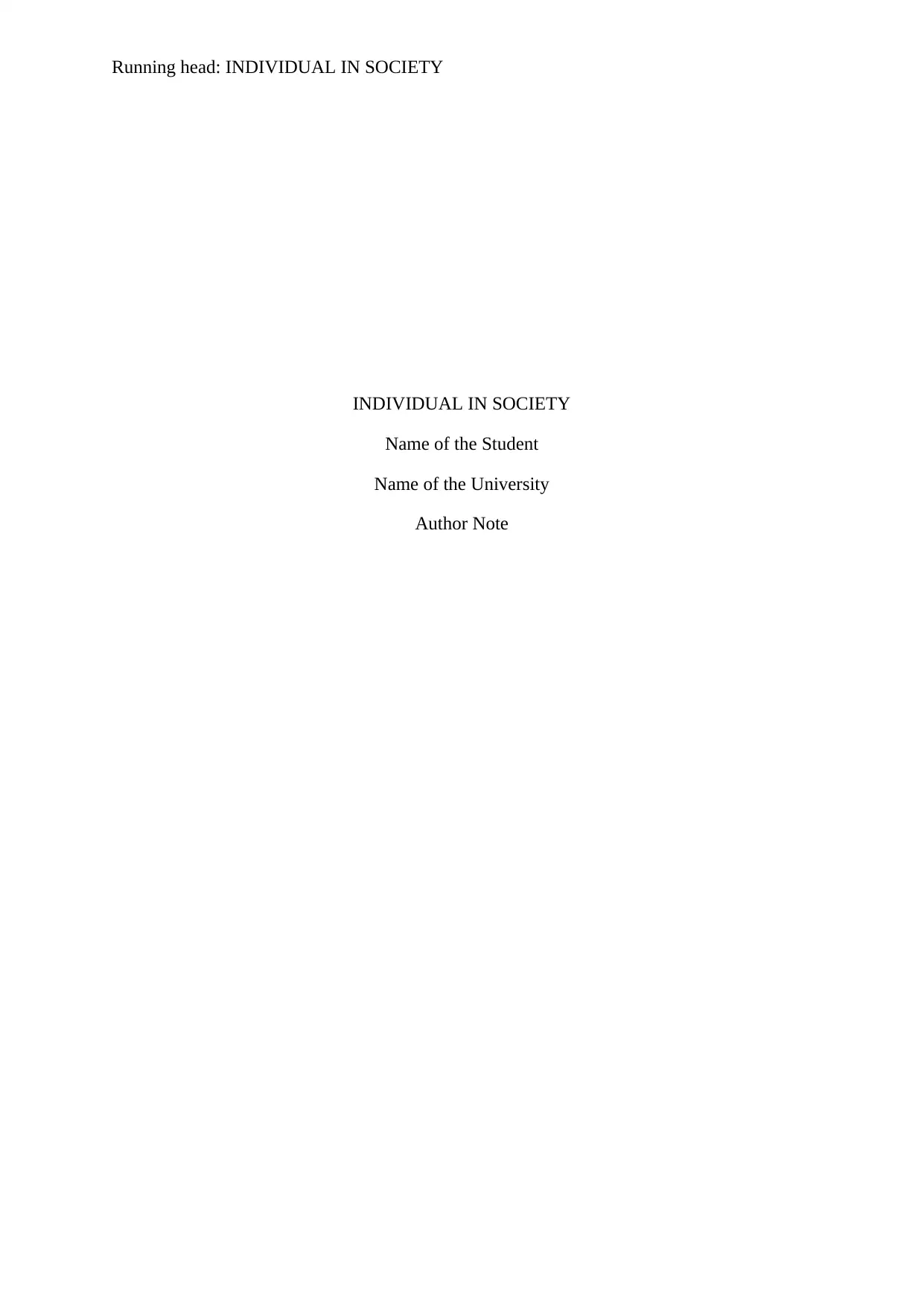
Running head: INDIVIDUAL IN SOCIETY
INDIVIDUAL IN SOCIETY
Name of the Student
Name of the University
Author Note
INDIVIDUAL IN SOCIETY
Name of the Student
Name of the University
Author Note
Paraphrase This Document
Need a fresh take? Get an instant paraphrase of this document with our AI Paraphraser
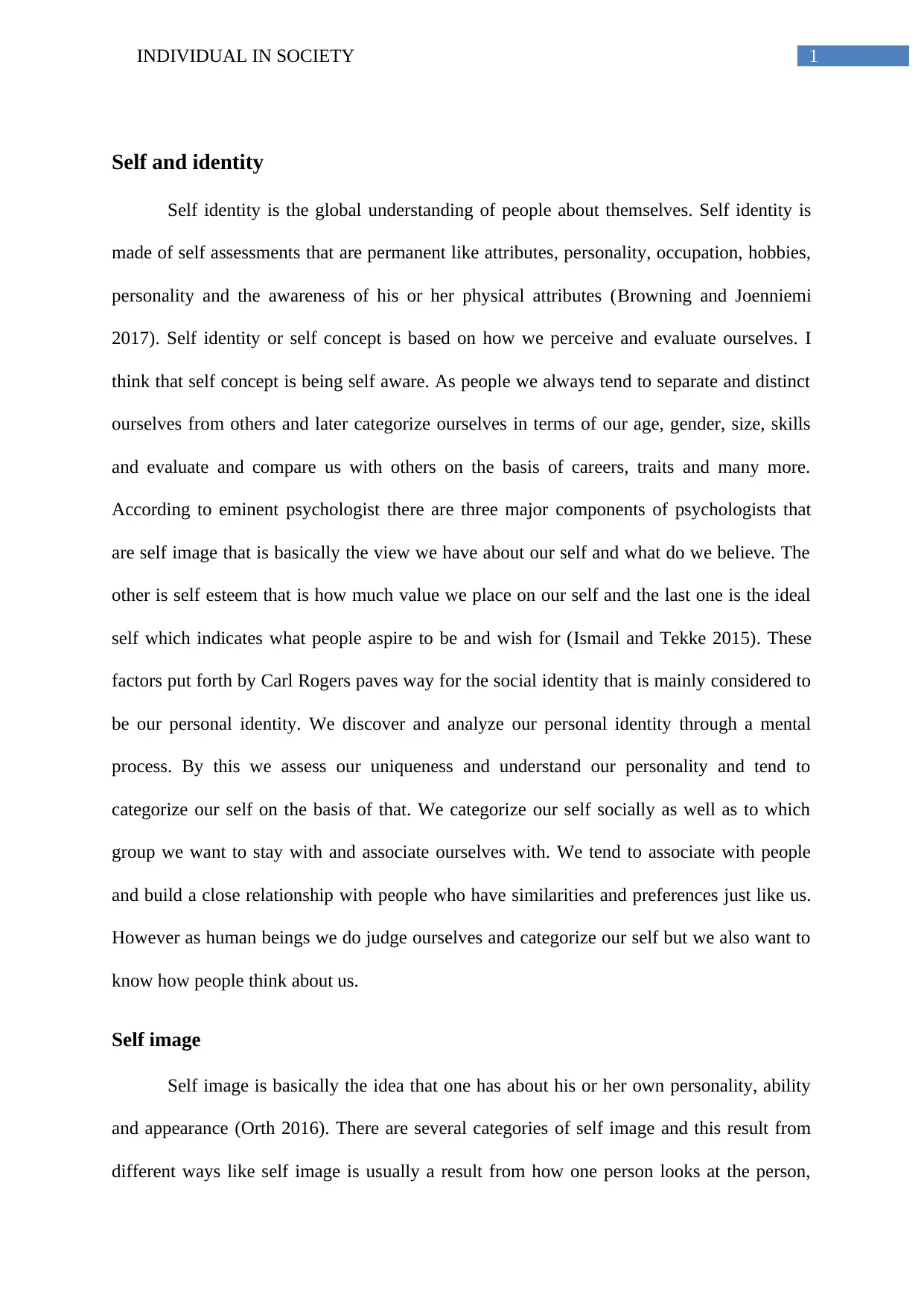
1INDIVIDUAL IN SOCIETY
Self and identity
Self identity is the global understanding of people about themselves. Self identity is
made of self assessments that are permanent like attributes, personality, occupation, hobbies,
personality and the awareness of his or her physical attributes (Browning and Joenniemi
2017). Self identity or self concept is based on how we perceive and evaluate ourselves. I
think that self concept is being self aware. As people we always tend to separate and distinct
ourselves from others and later categorize ourselves in terms of our age, gender, size, skills
and evaluate and compare us with others on the basis of careers, traits and many more.
According to eminent psychologist there are three major components of psychologists that
are self image that is basically the view we have about our self and what do we believe. The
other is self esteem that is how much value we place on our self and the last one is the ideal
self which indicates what people aspire to be and wish for (Ismail and Tekke 2015). These
factors put forth by Carl Rogers paves way for the social identity that is mainly considered to
be our personal identity. We discover and analyze our personal identity through a mental
process. By this we assess our uniqueness and understand our personality and tend to
categorize our self on the basis of that. We categorize our self socially as well as to which
group we want to stay with and associate ourselves with. We tend to associate with people
and build a close relationship with people who have similarities and preferences just like us.
However as human beings we do judge ourselves and categorize our self but we also want to
know how people think about us.
Self image
Self image is basically the idea that one has about his or her own personality, ability
and appearance (Orth 2016). There are several categories of self image and this result from
different ways like self image is usually a result from how one person looks at the person,
Self and identity
Self identity is the global understanding of people about themselves. Self identity is
made of self assessments that are permanent like attributes, personality, occupation, hobbies,
personality and the awareness of his or her physical attributes (Browning and Joenniemi
2017). Self identity or self concept is based on how we perceive and evaluate ourselves. I
think that self concept is being self aware. As people we always tend to separate and distinct
ourselves from others and later categorize ourselves in terms of our age, gender, size, skills
and evaluate and compare us with others on the basis of careers, traits and many more.
According to eminent psychologist there are three major components of psychologists that
are self image that is basically the view we have about our self and what do we believe. The
other is self esteem that is how much value we place on our self and the last one is the ideal
self which indicates what people aspire to be and wish for (Ismail and Tekke 2015). These
factors put forth by Carl Rogers paves way for the social identity that is mainly considered to
be our personal identity. We discover and analyze our personal identity through a mental
process. By this we assess our uniqueness and understand our personality and tend to
categorize our self on the basis of that. We categorize our self socially as well as to which
group we want to stay with and associate ourselves with. We tend to associate with people
and build a close relationship with people who have similarities and preferences just like us.
However as human beings we do judge ourselves and categorize our self but we also want to
know how people think about us.
Self image
Self image is basically the idea that one has about his or her own personality, ability
and appearance (Orth 2016). There are several categories of self image and this result from
different ways like self image is usually a result from how one person looks at the person,
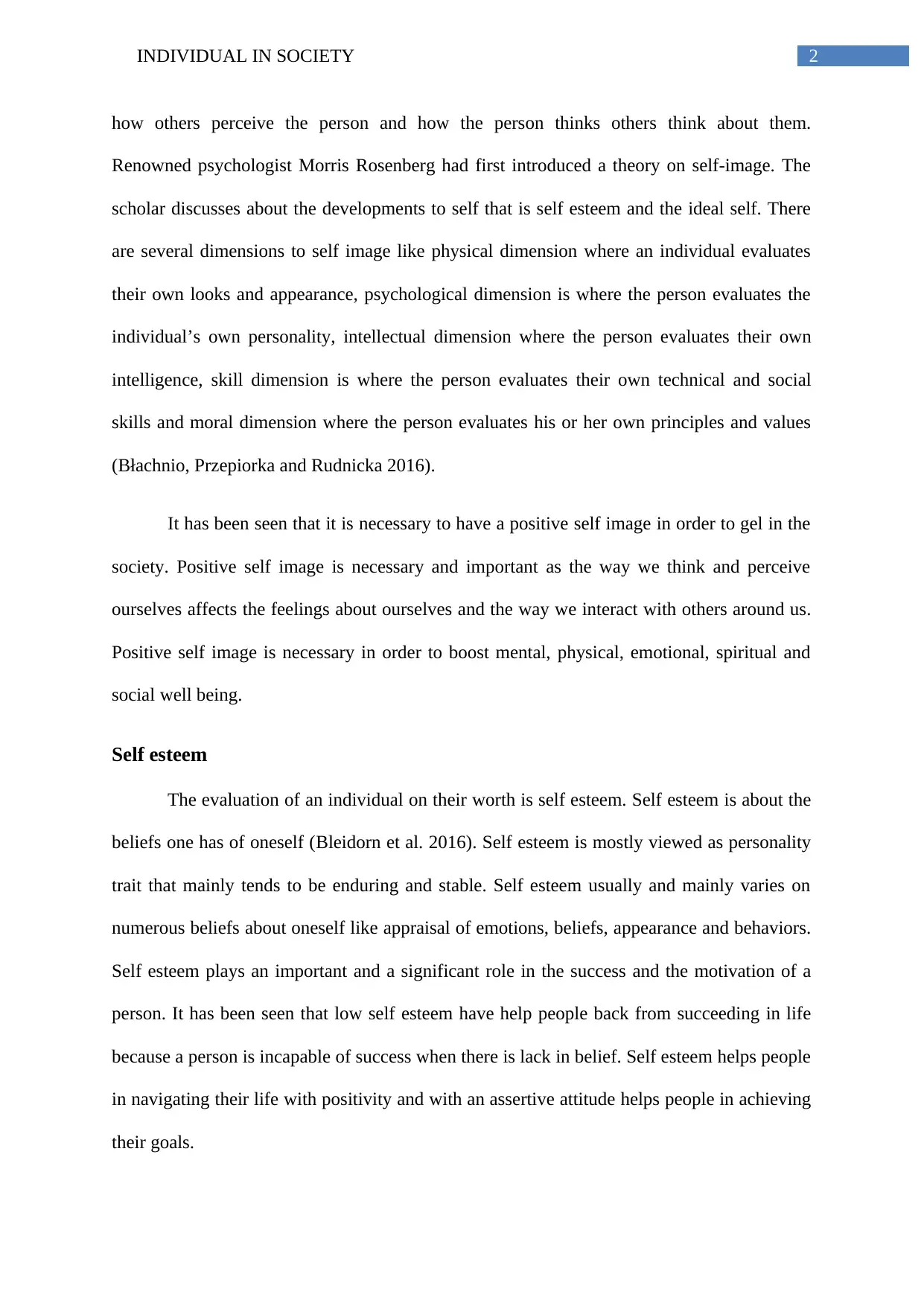
2INDIVIDUAL IN SOCIETY
how others perceive the person and how the person thinks others think about them.
Renowned psychologist Morris Rosenberg had first introduced a theory on self-image. The
scholar discusses about the developments to self that is self esteem and the ideal self. There
are several dimensions to self image like physical dimension where an individual evaluates
their own looks and appearance, psychological dimension is where the person evaluates the
individual’s own personality, intellectual dimension where the person evaluates their own
intelligence, skill dimension is where the person evaluates their own technical and social
skills and moral dimension where the person evaluates his or her own principles and values
(Błachnio, Przepiorka and Rudnicka 2016).
It has been seen that it is necessary to have a positive self image in order to gel in the
society. Positive self image is necessary and important as the way we think and perceive
ourselves affects the feelings about ourselves and the way we interact with others around us.
Positive self image is necessary in order to boost mental, physical, emotional, spiritual and
social well being.
Self esteem
The evaluation of an individual on their worth is self esteem. Self esteem is about the
beliefs one has of oneself (Bleidorn et al. 2016). Self esteem is mostly viewed as personality
trait that mainly tends to be enduring and stable. Self esteem usually and mainly varies on
numerous beliefs about oneself like appraisal of emotions, beliefs, appearance and behaviors.
Self esteem plays an important and a significant role in the success and the motivation of a
person. It has been seen that low self esteem have help people back from succeeding in life
because a person is incapable of success when there is lack in belief. Self esteem helps people
in navigating their life with positivity and with an assertive attitude helps people in achieving
their goals.
how others perceive the person and how the person thinks others think about them.
Renowned psychologist Morris Rosenberg had first introduced a theory on self-image. The
scholar discusses about the developments to self that is self esteem and the ideal self. There
are several dimensions to self image like physical dimension where an individual evaluates
their own looks and appearance, psychological dimension is where the person evaluates the
individual’s own personality, intellectual dimension where the person evaluates their own
intelligence, skill dimension is where the person evaluates their own technical and social
skills and moral dimension where the person evaluates his or her own principles and values
(Błachnio, Przepiorka and Rudnicka 2016).
It has been seen that it is necessary to have a positive self image in order to gel in the
society. Positive self image is necessary and important as the way we think and perceive
ourselves affects the feelings about ourselves and the way we interact with others around us.
Positive self image is necessary in order to boost mental, physical, emotional, spiritual and
social well being.
Self esteem
The evaluation of an individual on their worth is self esteem. Self esteem is about the
beliefs one has of oneself (Bleidorn et al. 2016). Self esteem is mostly viewed as personality
trait that mainly tends to be enduring and stable. Self esteem usually and mainly varies on
numerous beliefs about oneself like appraisal of emotions, beliefs, appearance and behaviors.
Self esteem plays an important and a significant role in the success and the motivation of a
person. It has been seen that low self esteem have help people back from succeeding in life
because a person is incapable of success when there is lack in belief. Self esteem helps people
in navigating their life with positivity and with an assertive attitude helps people in achieving
their goals.
⊘ This is a preview!⊘
Do you want full access?
Subscribe today to unlock all pages.

Trusted by 1+ million students worldwide
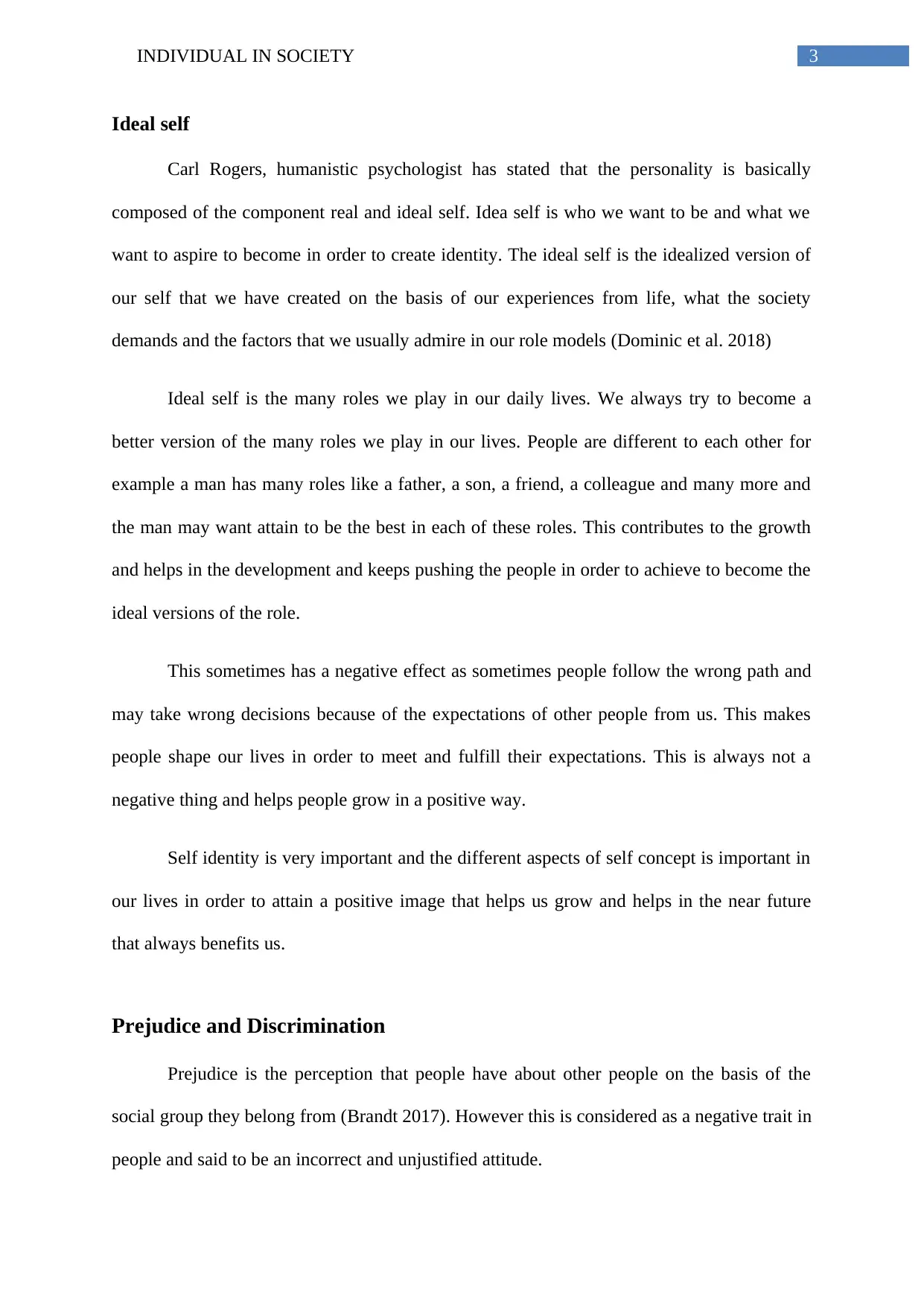
3INDIVIDUAL IN SOCIETY
Ideal self
Carl Rogers, humanistic psychologist has stated that the personality is basically
composed of the component real and ideal self. Idea self is who we want to be and what we
want to aspire to become in order to create identity. The ideal self is the idealized version of
our self that we have created on the basis of our experiences from life, what the society
demands and the factors that we usually admire in our role models (Dominic et al. 2018)
Ideal self is the many roles we play in our daily lives. We always try to become a
better version of the many roles we play in our lives. People are different to each other for
example a man has many roles like a father, a son, a friend, a colleague and many more and
the man may want attain to be the best in each of these roles. This contributes to the growth
and helps in the development and keeps pushing the people in order to achieve to become the
ideal versions of the role.
This sometimes has a negative effect as sometimes people follow the wrong path and
may take wrong decisions because of the expectations of other people from us. This makes
people shape our lives in order to meet and fulfill their expectations. This is always not a
negative thing and helps people grow in a positive way.
Self identity is very important and the different aspects of self concept is important in
our lives in order to attain a positive image that helps us grow and helps in the near future
that always benefits us.
Prejudice and Discrimination
Prejudice is the perception that people have about other people on the basis of the
social group they belong from (Brandt 2017). However this is considered as a negative trait in
people and said to be an incorrect and unjustified attitude.
Ideal self
Carl Rogers, humanistic psychologist has stated that the personality is basically
composed of the component real and ideal self. Idea self is who we want to be and what we
want to aspire to become in order to create identity. The ideal self is the idealized version of
our self that we have created on the basis of our experiences from life, what the society
demands and the factors that we usually admire in our role models (Dominic et al. 2018)
Ideal self is the many roles we play in our daily lives. We always try to become a
better version of the many roles we play in our lives. People are different to each other for
example a man has many roles like a father, a son, a friend, a colleague and many more and
the man may want attain to be the best in each of these roles. This contributes to the growth
and helps in the development and keeps pushing the people in order to achieve to become the
ideal versions of the role.
This sometimes has a negative effect as sometimes people follow the wrong path and
may take wrong decisions because of the expectations of other people from us. This makes
people shape our lives in order to meet and fulfill their expectations. This is always not a
negative thing and helps people grow in a positive way.
Self identity is very important and the different aspects of self concept is important in
our lives in order to attain a positive image that helps us grow and helps in the near future
that always benefits us.
Prejudice and Discrimination
Prejudice is the perception that people have about other people on the basis of the
social group they belong from (Brandt 2017). However this is considered as a negative trait in
people and said to be an incorrect and unjustified attitude.
Paraphrase This Document
Need a fresh take? Get an instant paraphrase of this document with our AI Paraphraser
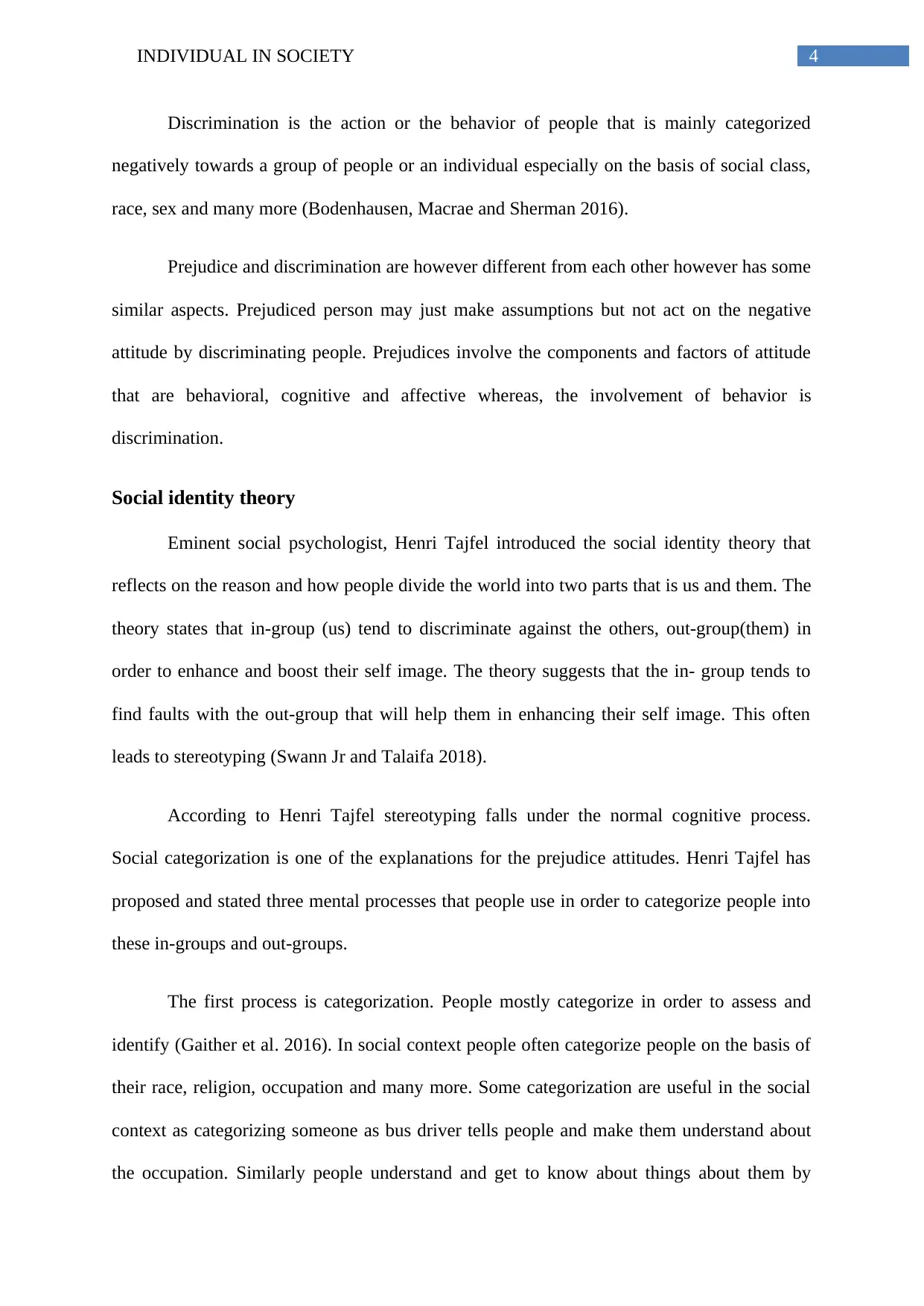
4INDIVIDUAL IN SOCIETY
Discrimination is the action or the behavior of people that is mainly categorized
negatively towards a group of people or an individual especially on the basis of social class,
race, sex and many more (Bodenhausen, Macrae and Sherman 2016).
Prejudice and discrimination are however different from each other however has some
similar aspects. Prejudiced person may just make assumptions but not act on the negative
attitude by discriminating people. Prejudices involve the components and factors of attitude
that are behavioral, cognitive and affective whereas, the involvement of behavior is
discrimination.
Social identity theory
Eminent social psychologist, Henri Tajfel introduced the social identity theory that
reflects on the reason and how people divide the world into two parts that is us and them. The
theory states that in-group (us) tend to discriminate against the others, out-group(them) in
order to enhance and boost their self image. The theory suggests that the in- group tends to
find faults with the out-group that will help them in enhancing their self image. This often
leads to stereotyping (Swann Jr and Talaifa 2018).
According to Henri Tajfel stereotyping falls under the normal cognitive process.
Social categorization is one of the explanations for the prejudice attitudes. Henri Tajfel has
proposed and stated three mental processes that people use in order to categorize people into
these in-groups and out-groups.
The first process is categorization. People mostly categorize in order to assess and
identify (Gaither et al. 2016). In social context people often categorize people on the basis of
their race, religion, occupation and many more. Some categorization are useful in the social
context as categorizing someone as bus driver tells people and make them understand about
the occupation. Similarly people understand and get to know about things about them by
Discrimination is the action or the behavior of people that is mainly categorized
negatively towards a group of people or an individual especially on the basis of social class,
race, sex and many more (Bodenhausen, Macrae and Sherman 2016).
Prejudice and discrimination are however different from each other however has some
similar aspects. Prejudiced person may just make assumptions but not act on the negative
attitude by discriminating people. Prejudices involve the components and factors of attitude
that are behavioral, cognitive and affective whereas, the involvement of behavior is
discrimination.
Social identity theory
Eminent social psychologist, Henri Tajfel introduced the social identity theory that
reflects on the reason and how people divide the world into two parts that is us and them. The
theory states that in-group (us) tend to discriminate against the others, out-group(them) in
order to enhance and boost their self image. The theory suggests that the in- group tends to
find faults with the out-group that will help them in enhancing their self image. This often
leads to stereotyping (Swann Jr and Talaifa 2018).
According to Henri Tajfel stereotyping falls under the normal cognitive process.
Social categorization is one of the explanations for the prejudice attitudes. Henri Tajfel has
proposed and stated three mental processes that people use in order to categorize people into
these in-groups and out-groups.
The first process is categorization. People mostly categorize in order to assess and
identify (Gaither et al. 2016). In social context people often categorize people on the basis of
their race, religion, occupation and many more. Some categorization are useful in the social
context as categorizing someone as bus driver tells people and make them understand about
the occupation. Similarly people understand and get to know about things about them by
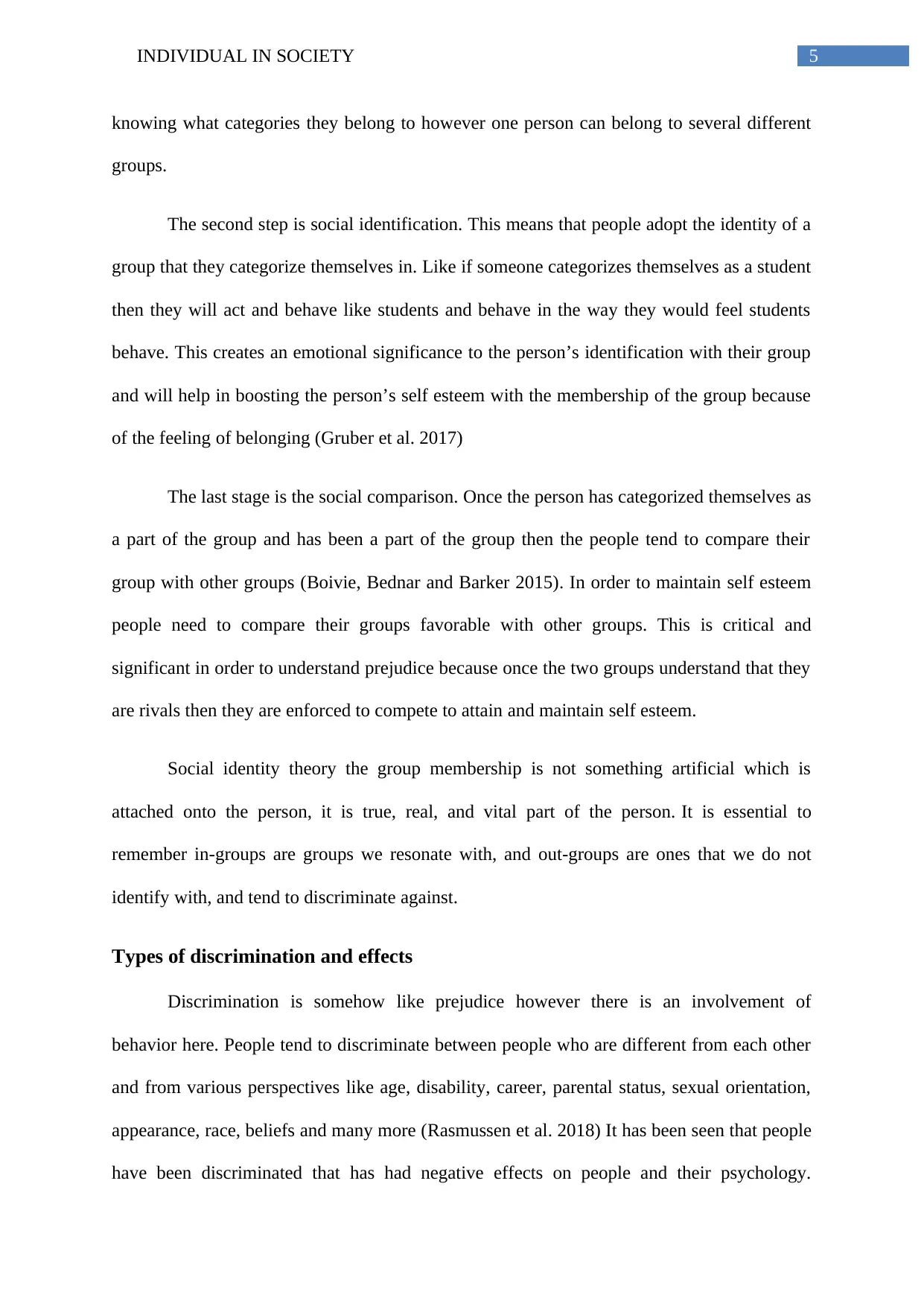
5INDIVIDUAL IN SOCIETY
knowing what categories they belong to however one person can belong to several different
groups.
The second step is social identification. This means that people adopt the identity of a
group that they categorize themselves in. Like if someone categorizes themselves as a student
then they will act and behave like students and behave in the way they would feel students
behave. This creates an emotional significance to the person’s identification with their group
and will help in boosting the person’s self esteem with the membership of the group because
of the feeling of belonging (Gruber et al. 2017)
The last stage is the social comparison. Once the person has categorized themselves as
a part of the group and has been a part of the group then the people tend to compare their
group with other groups (Boivie, Bednar and Barker 2015). In order to maintain self esteem
people need to compare their groups favorable with other groups. This is critical and
significant in order to understand prejudice because once the two groups understand that they
are rivals then they are enforced to compete to attain and maintain self esteem.
Social identity theory the group membership is not something artificial which is
attached onto the person, it is true, real, and vital part of the person. It is essential to
remember in-groups are groups we resonate with, and out-groups are ones that we do not
identify with, and tend to discriminate against.
Types of discrimination and effects
Discrimination is somehow like prejudice however there is an involvement of
behavior here. People tend to discriminate between people who are different from each other
and from various perspectives like age, disability, career, parental status, sexual orientation,
appearance, race, beliefs and many more (Rasmussen et al. 2018) It has been seen that people
have been discriminated that has had negative effects on people and their psychology.
knowing what categories they belong to however one person can belong to several different
groups.
The second step is social identification. This means that people adopt the identity of a
group that they categorize themselves in. Like if someone categorizes themselves as a student
then they will act and behave like students and behave in the way they would feel students
behave. This creates an emotional significance to the person’s identification with their group
and will help in boosting the person’s self esteem with the membership of the group because
of the feeling of belonging (Gruber et al. 2017)
The last stage is the social comparison. Once the person has categorized themselves as
a part of the group and has been a part of the group then the people tend to compare their
group with other groups (Boivie, Bednar and Barker 2015). In order to maintain self esteem
people need to compare their groups favorable with other groups. This is critical and
significant in order to understand prejudice because once the two groups understand that they
are rivals then they are enforced to compete to attain and maintain self esteem.
Social identity theory the group membership is not something artificial which is
attached onto the person, it is true, real, and vital part of the person. It is essential to
remember in-groups are groups we resonate with, and out-groups are ones that we do not
identify with, and tend to discriminate against.
Types of discrimination and effects
Discrimination is somehow like prejudice however there is an involvement of
behavior here. People tend to discriminate between people who are different from each other
and from various perspectives like age, disability, career, parental status, sexual orientation,
appearance, race, beliefs and many more (Rasmussen et al. 2018) It has been seen that people
have been discriminated that has had negative effects on people and their psychology.
⊘ This is a preview!⊘
Do you want full access?
Subscribe today to unlock all pages.

Trusted by 1+ million students worldwide
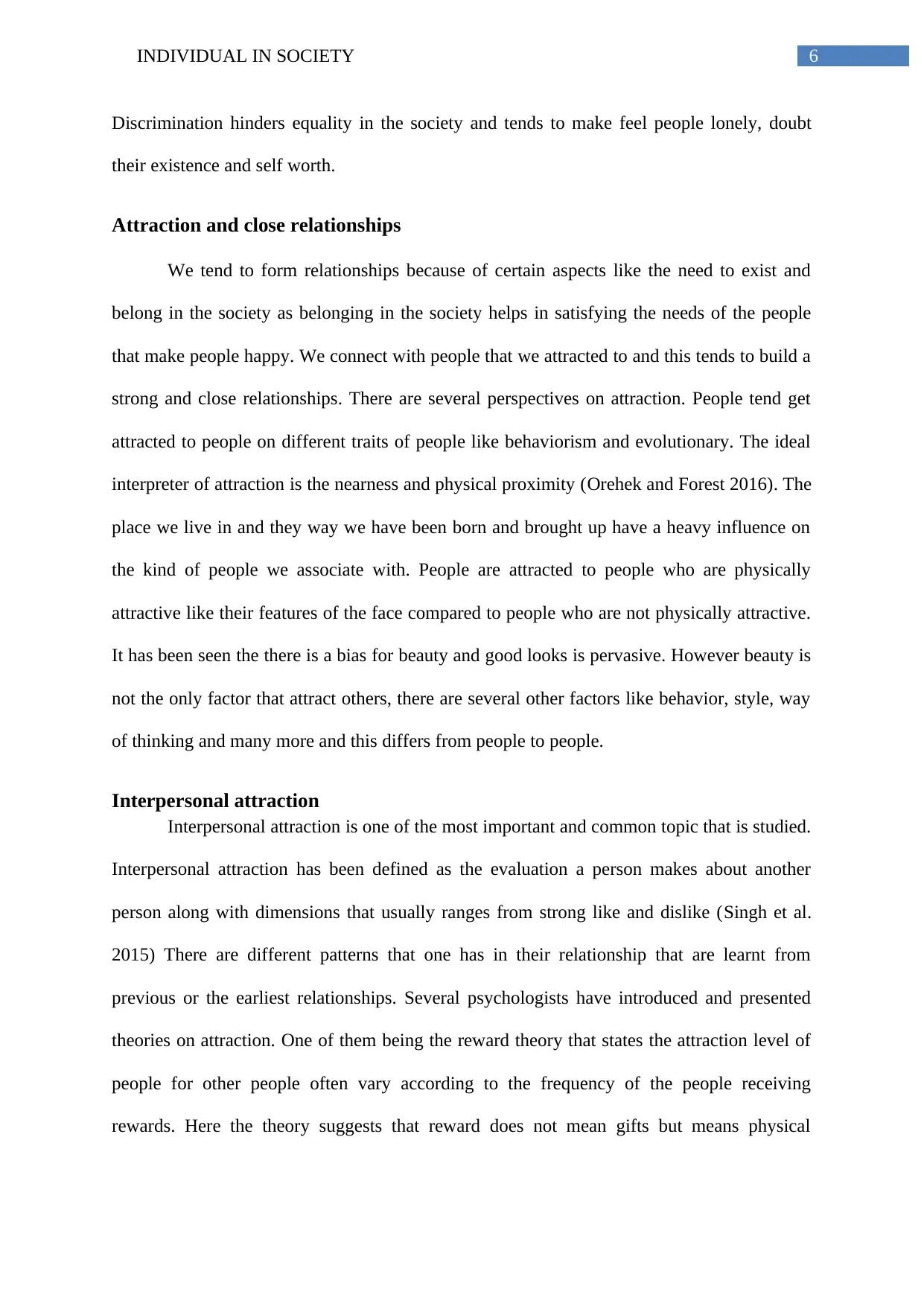
6INDIVIDUAL IN SOCIETY
Discrimination hinders equality in the society and tends to make feel people lonely, doubt
their existence and self worth.
Attraction and close relationships
We tend to form relationships because of certain aspects like the need to exist and
belong in the society as belonging in the society helps in satisfying the needs of the people
that make people happy. We connect with people that we attracted to and this tends to build a
strong and close relationships. There are several perspectives on attraction. People tend get
attracted to people on different traits of people like behaviorism and evolutionary. The ideal
interpreter of attraction is the nearness and physical proximity (Orehek and Forest 2016). The
place we live in and they way we have been born and brought up have a heavy influence on
the kind of people we associate with. People are attracted to people who are physically
attractive like their features of the face compared to people who are not physically attractive.
It has been seen the there is a bias for beauty and good looks is pervasive. However beauty is
not the only factor that attract others, there are several other factors like behavior, style, way
of thinking and many more and this differs from people to people.
Interpersonal attraction
Interpersonal attraction is one of the most important and common topic that is studied.
Interpersonal attraction has been defined as the evaluation a person makes about another
person along with dimensions that usually ranges from strong like and dislike (Singh et al.
2015) There are different patterns that one has in their relationship that are learnt from
previous or the earliest relationships. Several psychologists have introduced and presented
theories on attraction. One of them being the reward theory that states the attraction level of
people for other people often vary according to the frequency of the people receiving
rewards. Here the theory suggests that reward does not mean gifts but means physical
Discrimination hinders equality in the society and tends to make feel people lonely, doubt
their existence and self worth.
Attraction and close relationships
We tend to form relationships because of certain aspects like the need to exist and
belong in the society as belonging in the society helps in satisfying the needs of the people
that make people happy. We connect with people that we attracted to and this tends to build a
strong and close relationships. There are several perspectives on attraction. People tend get
attracted to people on different traits of people like behaviorism and evolutionary. The ideal
interpreter of attraction is the nearness and physical proximity (Orehek and Forest 2016). The
place we live in and they way we have been born and brought up have a heavy influence on
the kind of people we associate with. People are attracted to people who are physically
attractive like their features of the face compared to people who are not physically attractive.
It has been seen the there is a bias for beauty and good looks is pervasive. However beauty is
not the only factor that attract others, there are several other factors like behavior, style, way
of thinking and many more and this differs from people to people.
Interpersonal attraction
Interpersonal attraction is one of the most important and common topic that is studied.
Interpersonal attraction has been defined as the evaluation a person makes about another
person along with dimensions that usually ranges from strong like and dislike (Singh et al.
2015) There are different patterns that one has in their relationship that are learnt from
previous or the earliest relationships. Several psychologists have introduced and presented
theories on attraction. One of them being the reward theory that states the attraction level of
people for other people often vary according to the frequency of the people receiving
rewards. Here the theory suggests that reward does not mean gifts but means physical
Paraphrase This Document
Need a fresh take? Get an instant paraphrase of this document with our AI Paraphraser
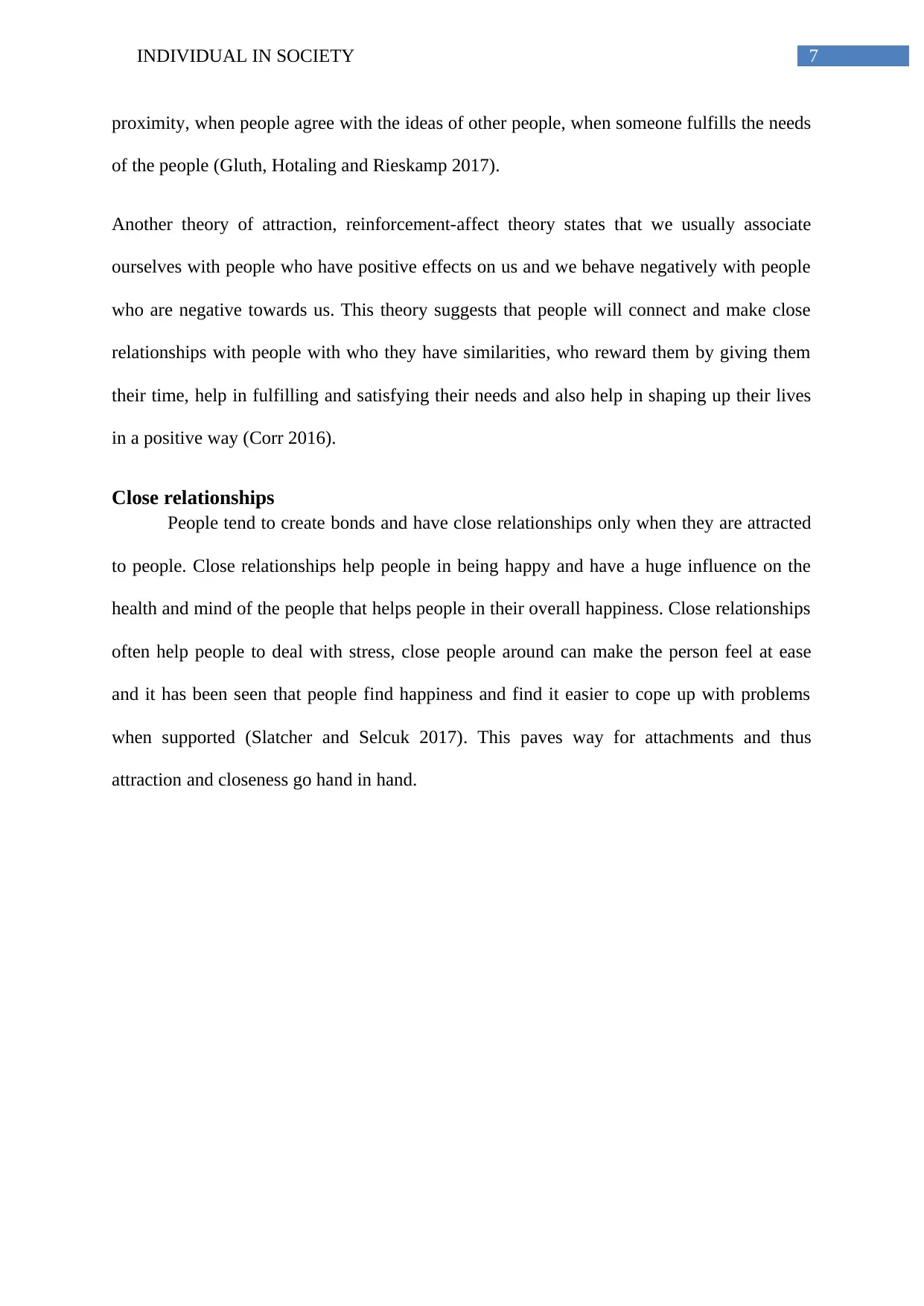
7INDIVIDUAL IN SOCIETY
proximity, when people agree with the ideas of other people, when someone fulfills the needs
of the people (Gluth, Hotaling and Rieskamp 2017).
Another theory of attraction, reinforcement-affect theory states that we usually associate
ourselves with people who have positive effects on us and we behave negatively with people
who are negative towards us. This theory suggests that people will connect and make close
relationships with people with who they have similarities, who reward them by giving them
their time, help in fulfilling and satisfying their needs and also help in shaping up their lives
in a positive way (Corr 2016).
Close relationships
People tend to create bonds and have close relationships only when they are attracted
to people. Close relationships help people in being happy and have a huge influence on the
health and mind of the people that helps people in their overall happiness. Close relationships
often help people to deal with stress, close people around can make the person feel at ease
and it has been seen that people find happiness and find it easier to cope up with problems
when supported (Slatcher and Selcuk 2017). This paves way for attachments and thus
attraction and closeness go hand in hand.
proximity, when people agree with the ideas of other people, when someone fulfills the needs
of the people (Gluth, Hotaling and Rieskamp 2017).
Another theory of attraction, reinforcement-affect theory states that we usually associate
ourselves with people who have positive effects on us and we behave negatively with people
who are negative towards us. This theory suggests that people will connect and make close
relationships with people with who they have similarities, who reward them by giving them
their time, help in fulfilling and satisfying their needs and also help in shaping up their lives
in a positive way (Corr 2016).
Close relationships
People tend to create bonds and have close relationships only when they are attracted
to people. Close relationships help people in being happy and have a huge influence on the
health and mind of the people that helps people in their overall happiness. Close relationships
often help people to deal with stress, close people around can make the person feel at ease
and it has been seen that people find happiness and find it easier to cope up with problems
when supported (Slatcher and Selcuk 2017). This paves way for attachments and thus
attraction and closeness go hand in hand.
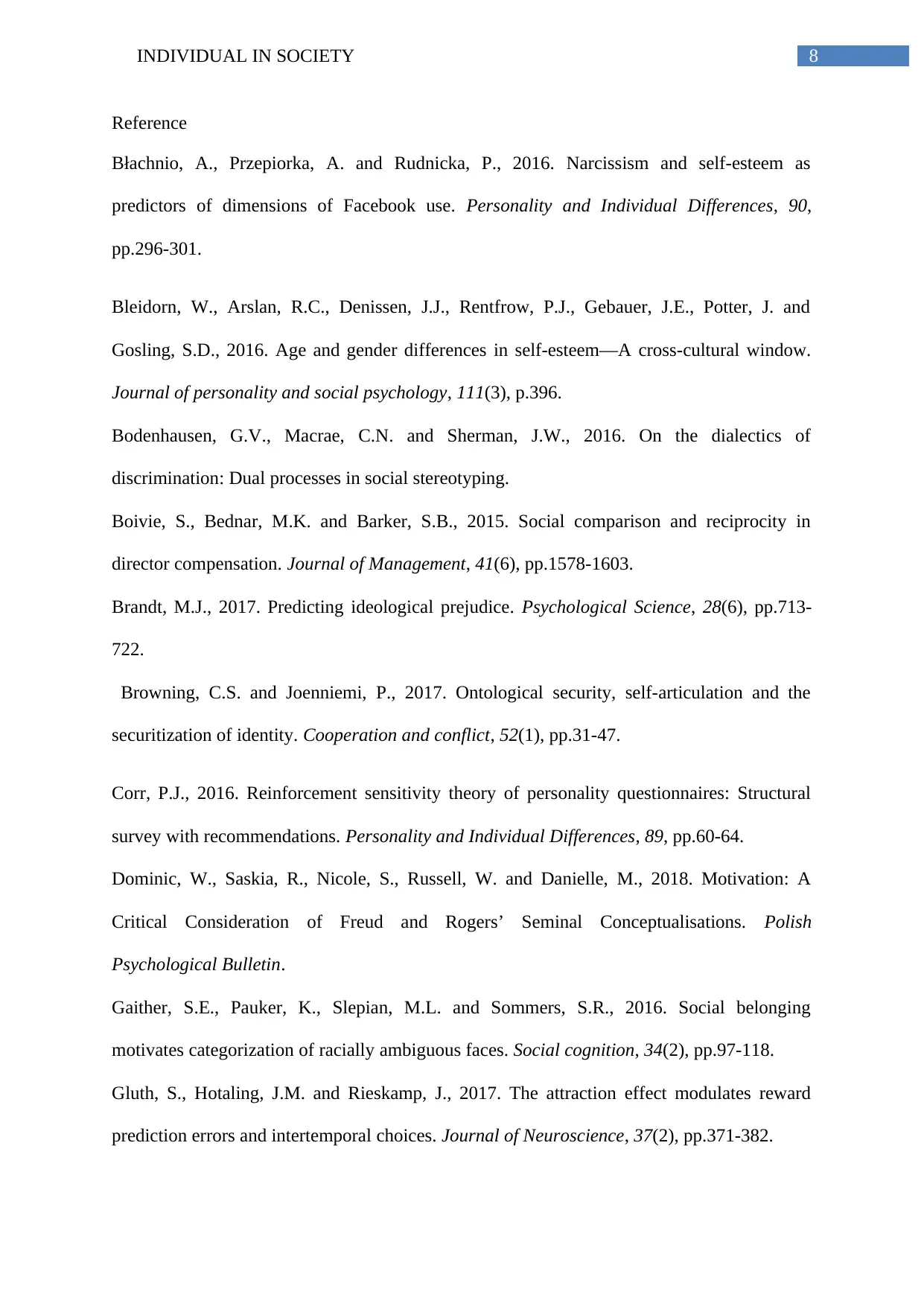
8INDIVIDUAL IN SOCIETY
Reference
Błachnio, A., Przepiorka, A. and Rudnicka, P., 2016. Narcissism and self-esteem as
predictors of dimensions of Facebook use. Personality and Individual Differences, 90,
pp.296-301.
Bleidorn, W., Arslan, R.C., Denissen, J.J., Rentfrow, P.J., Gebauer, J.E., Potter, J. and
Gosling, S.D., 2016. Age and gender differences in self-esteem—A cross-cultural window.
Journal of personality and social psychology, 111(3), p.396.
Bodenhausen, G.V., Macrae, C.N. and Sherman, J.W., 2016. On the dialectics of
discrimination: Dual processes in social stereotyping.
Boivie, S., Bednar, M.K. and Barker, S.B., 2015. Social comparison and reciprocity in
director compensation. Journal of Management, 41(6), pp.1578-1603.
Brandt, M.J., 2017. Predicting ideological prejudice. Psychological Science, 28(6), pp.713-
722.
Browning, C.S. and Joenniemi, P., 2017. Ontological security, self-articulation and the
securitization of identity. Cooperation and conflict, 52(1), pp.31-47.
Corr, P.J., 2016. Reinforcement sensitivity theory of personality questionnaires: Structural
survey with recommendations. Personality and Individual Differences, 89, pp.60-64.
Dominic, W., Saskia, R., Nicole, S., Russell, W. and Danielle, M., 2018. Motivation: A
Critical Consideration of Freud and Rogers’ Seminal Conceptualisations. Polish
Psychological Bulletin.
Gaither, S.E., Pauker, K., Slepian, M.L. and Sommers, S.R., 2016. Social belonging
motivates categorization of racially ambiguous faces. Social cognition, 34(2), pp.97-118.
Gluth, S., Hotaling, J.M. and Rieskamp, J., 2017. The attraction effect modulates reward
prediction errors and intertemporal choices. Journal of Neuroscience, 37(2), pp.371-382.
Reference
Błachnio, A., Przepiorka, A. and Rudnicka, P., 2016. Narcissism and self-esteem as
predictors of dimensions of Facebook use. Personality and Individual Differences, 90,
pp.296-301.
Bleidorn, W., Arslan, R.C., Denissen, J.J., Rentfrow, P.J., Gebauer, J.E., Potter, J. and
Gosling, S.D., 2016. Age and gender differences in self-esteem—A cross-cultural window.
Journal of personality and social psychology, 111(3), p.396.
Bodenhausen, G.V., Macrae, C.N. and Sherman, J.W., 2016. On the dialectics of
discrimination: Dual processes in social stereotyping.
Boivie, S., Bednar, M.K. and Barker, S.B., 2015. Social comparison and reciprocity in
director compensation. Journal of Management, 41(6), pp.1578-1603.
Brandt, M.J., 2017. Predicting ideological prejudice. Psychological Science, 28(6), pp.713-
722.
Browning, C.S. and Joenniemi, P., 2017. Ontological security, self-articulation and the
securitization of identity. Cooperation and conflict, 52(1), pp.31-47.
Corr, P.J., 2016. Reinforcement sensitivity theory of personality questionnaires: Structural
survey with recommendations. Personality and Individual Differences, 89, pp.60-64.
Dominic, W., Saskia, R., Nicole, S., Russell, W. and Danielle, M., 2018. Motivation: A
Critical Consideration of Freud and Rogers’ Seminal Conceptualisations. Polish
Psychological Bulletin.
Gaither, S.E., Pauker, K., Slepian, M.L. and Sommers, S.R., 2016. Social belonging
motivates categorization of racially ambiguous faces. Social cognition, 34(2), pp.97-118.
Gluth, S., Hotaling, J.M. and Rieskamp, J., 2017. The attraction effect modulates reward
prediction errors and intertemporal choices. Journal of Neuroscience, 37(2), pp.371-382.
⊘ This is a preview!⊘
Do you want full access?
Subscribe today to unlock all pages.

Trusted by 1+ million students worldwide
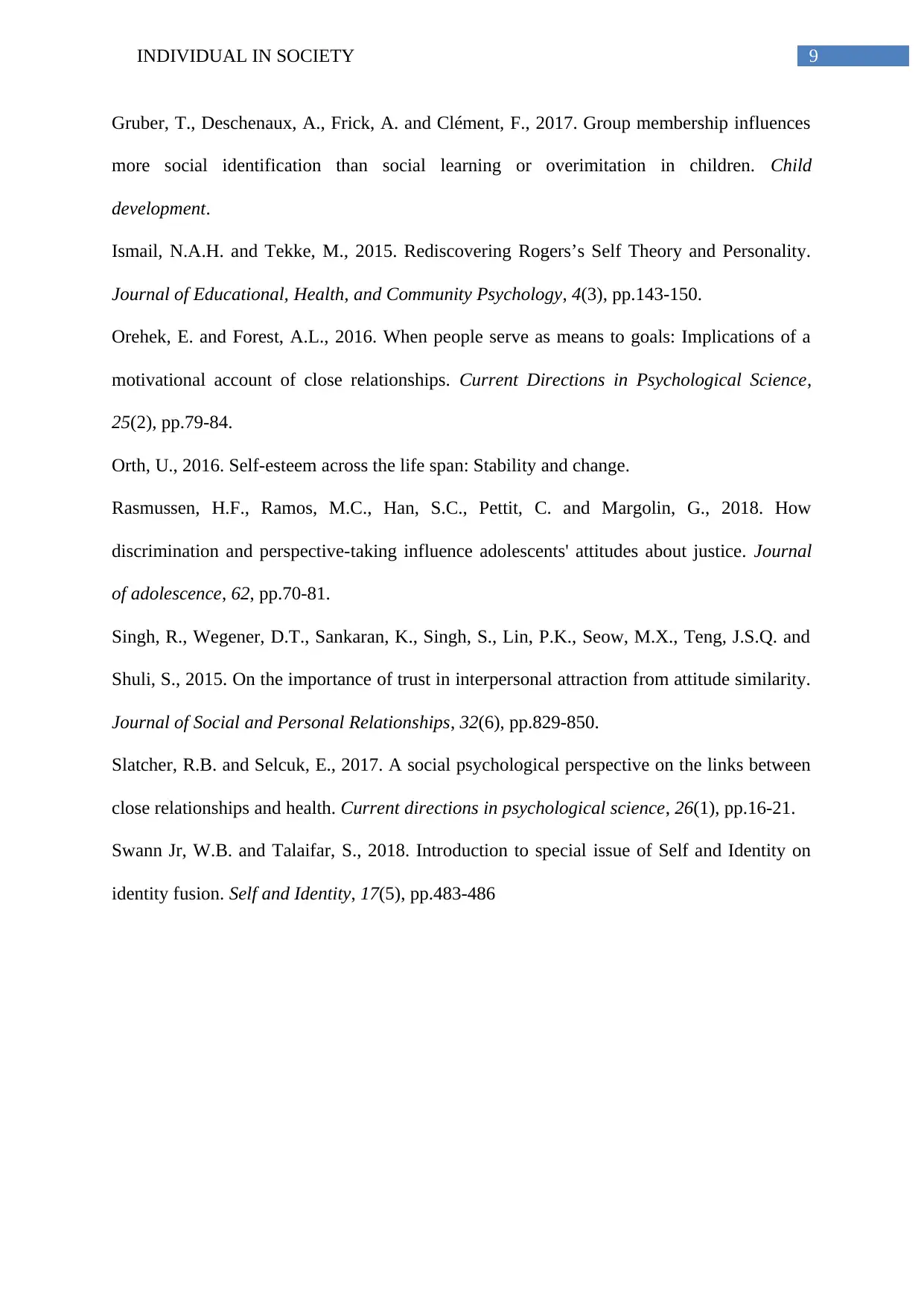
9INDIVIDUAL IN SOCIETY
Gruber, T., Deschenaux, A., Frick, A. and Clément, F., 2017. Group membership influences
more social identification than social learning or overimitation in children. Child
development.
Ismail, N.A.H. and Tekke, M., 2015. Rediscovering Rogers’s Self Theory and Personality.
Journal of Educational, Health, and Community Psychology, 4(3), pp.143-150.
Orehek, E. and Forest, A.L., 2016. When people serve as means to goals: Implications of a
motivational account of close relationships. Current Directions in Psychological Science,
25(2), pp.79-84.
Orth, U., 2016. Self-esteem across the life span: Stability and change.
Rasmussen, H.F., Ramos, M.C., Han, S.C., Pettit, C. and Margolin, G., 2018. How
discrimination and perspective-taking influence adolescents' attitudes about justice. Journal
of adolescence, 62, pp.70-81.
Singh, R., Wegener, D.T., Sankaran, K., Singh, S., Lin, P.K., Seow, M.X., Teng, J.S.Q. and
Shuli, S., 2015. On the importance of trust in interpersonal attraction from attitude similarity.
Journal of Social and Personal Relationships, 32(6), pp.829-850.
Slatcher, R.B. and Selcuk, E., 2017. A social psychological perspective on the links between
close relationships and health. Current directions in psychological science, 26(1), pp.16-21.
Swann Jr, W.B. and Talaifar, S., 2018. Introduction to special issue of Self and Identity on
identity fusion. Self and Identity, 17(5), pp.483-486
Gruber, T., Deschenaux, A., Frick, A. and Clément, F., 2017. Group membership influences
more social identification than social learning or overimitation in children. Child
development.
Ismail, N.A.H. and Tekke, M., 2015. Rediscovering Rogers’s Self Theory and Personality.
Journal of Educational, Health, and Community Psychology, 4(3), pp.143-150.
Orehek, E. and Forest, A.L., 2016. When people serve as means to goals: Implications of a
motivational account of close relationships. Current Directions in Psychological Science,
25(2), pp.79-84.
Orth, U., 2016. Self-esteem across the life span: Stability and change.
Rasmussen, H.F., Ramos, M.C., Han, S.C., Pettit, C. and Margolin, G., 2018. How
discrimination and perspective-taking influence adolescents' attitudes about justice. Journal
of adolescence, 62, pp.70-81.
Singh, R., Wegener, D.T., Sankaran, K., Singh, S., Lin, P.K., Seow, M.X., Teng, J.S.Q. and
Shuli, S., 2015. On the importance of trust in interpersonal attraction from attitude similarity.
Journal of Social and Personal Relationships, 32(6), pp.829-850.
Slatcher, R.B. and Selcuk, E., 2017. A social psychological perspective on the links between
close relationships and health. Current directions in psychological science, 26(1), pp.16-21.
Swann Jr, W.B. and Talaifar, S., 2018. Introduction to special issue of Self and Identity on
identity fusion. Self and Identity, 17(5), pp.483-486
Paraphrase This Document
Need a fresh take? Get an instant paraphrase of this document with our AI Paraphraser

10INDIVIDUAL IN SOCIETY
1 out of 11
Related Documents
Your All-in-One AI-Powered Toolkit for Academic Success.
+13062052269
info@desklib.com
Available 24*7 on WhatsApp / Email
![[object Object]](/_next/static/media/star-bottom.7253800d.svg)
Unlock your academic potential
Copyright © 2020–2025 A2Z Services. All Rights Reserved. Developed and managed by ZUCOL.





